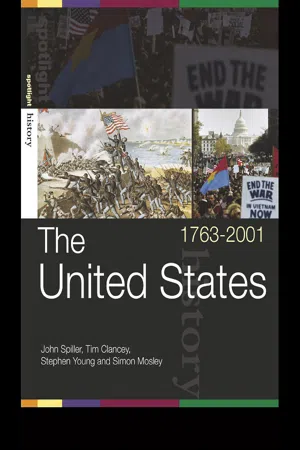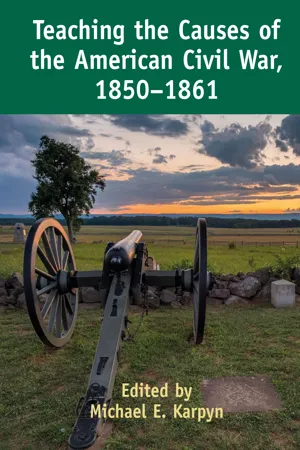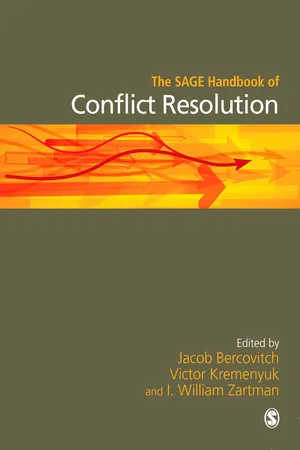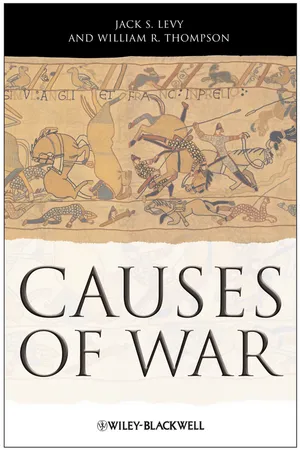History
Causes of the Civil War
The causes of the Civil War in the United States were rooted in long-standing tensions over issues such as slavery, states' rights, and economic differences between the North and South. The election of Abraham Lincoln in 1860, who opposed the expansion of slavery, further heightened these tensions, ultimately leading to the secession of Southern states and the outbreak of war in 1861.
Written by Perlego with AI-assistance
Related key terms
1 of 5
7 Key excerpts on "Causes of the Civil War"
- eBook - PDF
- Keith D. Dickson(Author)
- 2022(Publication Date)
- For Dummies(Publisher)
1 The War and Its Causes IN THIS PART . . . Get a handle on the conditions that were shaping the United States and causing trouble. Figure out what a civil war is. War! War! War! So much goes into starting one. CHAPTER 1 How Did the War Happen? 9 Chapter 1 How Did the War Happen? S ince the founding of the United States, different sections of the country had interests and priorities that competed with the interests and priorities of other sections. These conflicts had always been resolved through politics (usually some form of congressional dealmaking). However, beginning in the 1850s, the political process for resolving these disputes became less and less effective. The differences between sections of the country were so great at that time that the survival of the union of states was in danger. Peace depended upon compromise and conciliation between congressional leaders representing each section. This chapter examines the sectional differences between the North and South that led to such a dangerous situation and provides some background to the controversies that led to the Civil War. The Big Picture: War and Politics Wars have many causes. No one should ever forget that wars are fought for politi -cal reasons and objectives. Essentially, people or nations go to war to protect a vital interest, to defend territory from an aggressor, or to achieve a moral purpose (such as defending the innocent and punishing an evil). The Civil War included all IN THIS CHAPTER » Taking a look at the big picture » Defining a “civil war” » Understanding the distinction between North and South » Exploring the issues 10 PART 1 The War and Its Causes of these rationales. Each side used all three justifications for fighting the other during the four years of war. And, interestingly enough, each side had a strong, valid, substantial reason for doing so. What’s a civil war? You hear the word civil in such terms as civil rights, civilian, and civil liberty. - eBook - PDF
The American Civil War
A Handbook of Literature and Research
- Steven E. Woodworth(Author)
- 1996(Publication Date)
- Greenwood(Publisher)
Kent: Kent State University Press, 1990. Walther, Eric. The Fire-Eaters. Baton Rouge: Louisiana State University Press, 1992. Wiecek, William. "Slavery and Abolition before the United States Supreme Court, 1820- 1860." Journal of American History 65 (1978): 34-59. . The Sources of Antislavery Constitutionalism in America, 1760-1848. Ithaca: Cornell University Press, 1977. 13 Economic Factors James M. Russell Two questions are important to an understanding of the causes of the American Civil War. Why did eleven states risk war by seceding from the Union, begin- ning with South Carolina on December 20, 1860? And why did the North choose to fight to preserve the Union? The bulk of the historiography on Civil War causation attempts to answer only one of these questions at a time, with far more work addressing the topic of Southern secession. It is fair to add that most studies on the Causes of the Civil War have downplayed economic factors. In an historiographical survey, "The Irrepressible Conflict," included in his The Imperiled Union: Essays on the Background of the Civil War (1980), Ken- neth Stampp divides most twentieth-century work on Civil War causation into three categories: those that argue for economic determinism; those that embrace a "slavery/cultural concept," which minimizes economic factors; and those that adhere to James G. Randall's "blundering generation hypothesis," which rejects the importance of both economic and cultural factors and emphasizes instead the significance of irresponsible, fanatical agitators and incompetent politicians. MARXIST PERSPECTIVES Not surprisingly, those who fit into Stampp's first category—economic de- terminism—have been Marxist historians, who tend to follow Marx's tenet that economic factors are the prime moving forces in history. One of the first to apply Marxist thinking to the Causes of the Civil War was A. - eBook - ePub
Walking Through History
Constitution & the New Government, Westward Expansion, and Civil War
- Andi Stix, Frank Hrbek(Authors)
- 2023(Publication Date)
- Routledge(Publisher)
Topic III Civil War DOI: 10.4324/9781003259022-12 Background Information and Causes of the Civil War Slavery, economics, and lifestyle were the Causes of the Civil War. These were undeniable facts. It is true that Abraham Lincoln called for volunteers to suppress the rebellion of the southern states. It is also accepted that Abraham Lincoln was determined to keep the Union together and quite willing to compromise the issue of slavery to attain that end. But no matter how we look at all of these issues that led to such horrendous bloodshed, slavery was the underlying reason for it all. The election of Abraham Lincoln in 1860 was the final straw. With Lincoln in the White House, and the Republicans in power in Washington, D.C., the southerners knew their days were numbered. They were losing their grip on the Federal government. The admission of California into the Union as a free state, in 1850, signaled the end of the balance of power in the United States Senate. The northern states already dominated the House of Representatives, for twice as many people lived north of the Mason-Dixon Line and out West than did in the southern states. The southern politicians felt that this shift in power spelled the doom of slavery, that it was inevitable their peculiar institution would be eventually legislated out of existence. This conflict had its roots in our nation’s founding, at the sessions of the Second Continental Congress when the Declaration of Independence, written by Thomas Jefferson, was presented to the delegates for their approval and acceptance. John Adams and Benjamin Franklin, along with Thomas Jefferson, wanted to abolish slavery so that the words, All men are created equal would have meaning and significance to the American bid for freedom and independence. That phrase would remain tainted by hypocrisy because the South refused to accept the declaration as written if the clause abolishing slavery remained in the document - eBook - ePub
- Tim Clancey, Simon Mosley, John Spiller, Stephen Young(Authors)
- 2004(Publication Date)
- Routledge(Publisher)
Chapter 3 The Origins of the American Civil War, 1840–1861This chapter will examine the debates over slavery, states’ rights and federal rights, and the sectional differences which gave rise to the secession of the Confederate states and the subsequent outbreak of the American Civil War.Historical background Sources IntroductionThe problems of territorial expansion and attempts at compromiseEconomic differences and the moral implications of slaveryStates’ rights and nationalismSectional divisions and conspiracy theoriesLeadership: politicians and partiesConclusion 1 Understanding the Northern perspective2 Understanding the Southern perspective Historical skills1 Conspiracy everywhere2 Who was most to blame? EssaysExpansion and slaveryIrresponsible agitators and blundering politiciansMotives for secession and fighting Chronology
1820 Missouri Compromise 1831 First issue of The Liberator publishedNat Turner Revolt 1832-3 Nullification Crisis 1836 Texas won independence from Mexico 1840 Whig William Harrison elected President 1841 Harrison died and Tyler became President 1844 Democrat James Polk elected President - Michael E. Karpyn, Caroline R. Pryor, Erik Alexander, Charlotte Johnson, James Mitchell, Whitney Blankenship(Authors)
- 2020(Publication Date)
Yes, the war is part of our collective history; however, many are either ignorant of, or choose to ignore, the causes of the war. History teachers in the South face the challenge of teaching the election of 1860 when place- based identities (Jennings, Swidler, & Koliba, 2005) may contribute to the 78 ELIZABETH BARROW sustained legacy of the Confederate States of America. The lessons associated with this chapter offer two examples of how teachers can challenge students to think more critically about the Causes of the Civil War within the context of political, social, and economic history. Four Candidates, Two Races, One Main Issue The election of 1860 was a particularly interesting one in American his- tory. Four candidates vying for president of the United States ran in what was essentially two separate elections: Lincoln (Republican) and Douglas (Northern Democrat) in the North and Breckinridge (Southern Democrat) and Bell (Constitutional Unionist) in the South. Popular history contends that the two races were completely separate; however, this is inaccurate. The Constitutional Union party did try to tarnish both the Republican and Northern Democrat campaigns while both sides of the Democratic party con- centrated on attacking each other (Holt, 2017). Slavery was not the only issue contested in the election of 1860 but it did largely dominate conver- sations. In order to understand the complexity of the election of 1860 and how it was a cause of the Civil War I will briefly introduce the four parties and explain their position on slavery in the territories. The election of 1860 marks only the second presidential election for the Republican party. Although he did not win, John C. Frémont’s success in 1856 insured that the Republican party would be considered a mainstream party, unlike the waning Know-Nothing party. Since its inception, the Republican party “intensified partisan debate about freedom” (Neely, 1991, p. xiii).- eBook - PDF
- Jacob Bercovitch, Victor Kremenyuk, I William Zartman, Jacob Bercovitch, Victor Kremenyuk, I William Zartman(Authors)
- 2008(Publication Date)
- SAGE Publications Ltd(Publisher)
Whereas relations between states have always been a central topic in the study of conflict, much of the academic research on civil war has treated conflict within countries primarily as a “domestic” or “internal” issue, where the causes and consequences of conflict have been assumed to be confined to the country where the conflict takes place. Researchers have related civil war to various domestic explanatory factors such as a country’s income (e.g. Collier and Hoeffler 2004), state strength and factors determining the opportunities for insurgencies such as mountainous terrain (e.g. Fearon and Laitin 2003), or political instability (e.g. Hegre et al. 2001). However, there are many reasons to question whether such a “closed polity” approach – where individual states are treated as isolated units, unaffected by events and actors in other states – can be appropriate for 596 THE SAGE HANDBOOK OF CONFLICT RESOLUTION understanding civil war and the full range of their consequences. Many researchers have pointed to how civil wars often display various transnational dimensions (e.g. Brown 1993, 1996; Gleditsch 2007; Salehyan and Gleditsch 2006). The actors involved in violent civil conflicts in a given state are often linked in various ways to actors in other states. These transnational linkages imply that we will often need to look beyond individual nation states to understand why conflicts turn violent and evolve in particular ways. Furthermore, the consequences of intrastate conflicts are not necessarily limited to the individual state where violence first occurs. Violence in civil wars often crosses national boundaries, and there is an increasing recognition that conflict in one state may spread and foster violence in other states, as well as generate conflict between nation states. Moreover, the consequences of civil war may spread and affect other states through externalities of conflict such as refugees and the economic impact of conflict in neighboring countries. - eBook - ePub
- Jack S. Levy, William R. Thompson(Authors)
- 2011(Publication Date)
- Wiley-Blackwell(Publisher)
The nature of the motive–opportunity debate will be elaborated below. Suffice it to say that most recent analyses have focused on opportunity factors–that is, what factors make it easier or more difficult to rebel for whatever reason. The lists of factors that are put forward tend to be multi -level, encompassing primarily systemic through group considerations. Motivation has been considered too difficult to capture in general terms. The onset–duration problem, most succinctly put, is that many of these opportunity factors (and motivation factors, for that matter) can be applied to explain why civil wars begin, why some become unusually protracted, or both. Although authors often specify that they are addressing either onset or duration, onset and duration still tend to become conflated. There is also a fair amount of disagreement. One person’s onset factor is another person’s duration factor and vice versa. We are no more likely to impose a tight order on these materials than the analysts already have, but we can try to communicate the nature of the disagreements. Thus, a different presentation strategy for civil war causes seems necessary. We will keep levels of analysis in mind but not insist that the arguments about the causes of civil war fit within them neatly.To set the stage for discussing different interpretations of civil war causes, we need to introduce briefly the “old war/new war” debate, which we mentioned in chapter 1. Emblematic of this debate is Kaldor’s (1999) perspective. Kaldor maintains that the type of warfare that became most prevalent in the past three to four centuries was closely tied to the relatively recent emergence of the nation-state organizational format. The primary goals of interstate warfare moved from a focus on territorial delineations and aristocratic inheritance squabbles to national and ideological disputes. In conjunction with these shifting goals, states became predominant and increasingly inclined to operate as blocs. Their armies transited through corresponding shifts of emphasis on mercenaries, professionals, conscripts, and back to professionals, this time with high technological proficiencies. Reliance on firearms gave way gradually to industrialized technology and successively greater lethality. All of these changes were supported by the expansion of the state’s bureaucracy, increasingly effective means of mobilizing resources from the population and economy, and tighter connections between state, military, and industry.8 Along the way and equally linked closely to the evolution of the modern state, a number of distinctions between what is public and private, internal and external, economic and political, civilian and military, and war and peace came into practice.Kaldor’s basic argument is that just as the wars with which we are most familiar were closely linked to the evolution of the modern state, the emergence of different types of political organization will lead to the supplanting of the old forms of warfare and associated conventions by new types of war and related norms. What is interesting is that the way these processes are currently working, at least in some parts of the world, is the exact opposite of the way they worked in early modern Europe. In earlier centuries, European rulers fought to establish control over specified territory and populations in order to create a fiscal foundation for state power. In doing so, they created a variety of distinctions, including one that differentiated domestic politics from the fluctuations of external politics. Maintaining this distinction meant suppressing domestic disorder, monopolizing armed forces, and staving off foreign attacks. Other things being equal, success in these endeavors led to political legitimacy within the territorial boundaries of the state, professionalized standing armies, and intermittent engagement in interstate wars.
Index pages curate the most relevant extracts from our library of academic textbooks. They’ve been created using an in-house natural language model (NLM), each adding context and meaning to key research topics.






